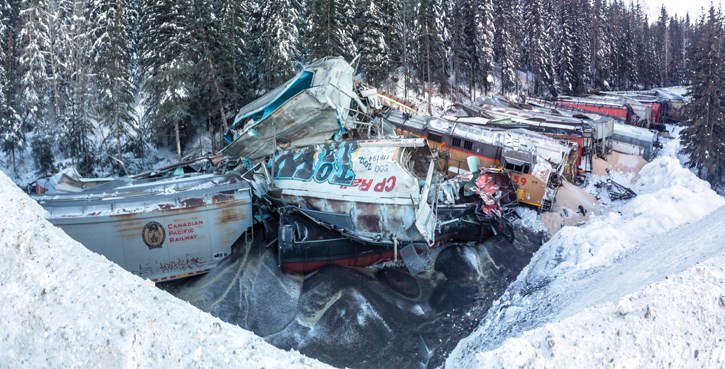FIELD, B.C. – A freight train that derailed in Yoho National Park this week that killed three Canadian Pacific Railway crew members from Calgary had its air brakes applied, but did not have the hand brakes engaged allowing the stationary train to take off at unsafe speeds.
The fact the train did not have its hand brakes engaged was revealed during a Transportation Safety Board of Canada (TSB) press conference Tuesday (Feb. 5), by senior investigator James Carmichael.
Carmichael was blunt about the “challenging” terrain through the Spiral tunnels east of Field, B.C. where 99 cars and two locomotives derailed at about 1 a.m. on Monday (Feb. 4).
“This territory is among the most challenging railway territory in North America,” Carmichael said.
“Investigators and others are working hard under challenging circumstances to fully understand what went so terribly wrong.”
The train, which was carrying grain and canola oil, departed from Red Deer and was heading to Vancouver, B.C. when it stopped in Partridge, the last station prior to the entrance to the Upper Spiral Tunnel, for a crew shift change on Sunday (Feb. 3) night.
During the crew changeover, conductor Dylan Paradis, engineer Andrew Dockrell, and trainee Daniel Waldenberger-Bulmer boarded the westbound train when it began to move on its own.
“The occurrence crew had just arrived and boarded the train, but were not yet ready to depart. The train had been stopped on the grade, with the airbrakes in emergency for about two hours when the train began to move on its own,” Carmichael said.
“There were no handbrakes applied on the train. The train then accelerated to a speed well in excess of maximum track speed of 20 miles per hour for the tight curves and steep mountain grade and the train derailed.”
All three men were killed.
With the investigation in the early stages, TSB officials said they will examine all the information before drawing any conclusion.
“It’s too early to say the cause and what contributing factors of this accident might be,” Carmichael said.
THREE LIVES LOST
Condolences flooded Albe Bulmer’s social media status hours after he announced his son, Daniel Waldenberger-Bulmer, was one of the three men who died.
“I am sad to report that I have lost one of the jewels in my crown last night in a tragic accident while he was training to be a conductor for CP rail,” Albe Bulmer wrote.
“He will be sadly missed by me his father and mentor as he loved adventure and challenges as I do … my heart also goes out to his coworkers’ family and friends as well.”
Alberta Premier Rachel Notley sent a message to the families and co-workers on Monday, noting “I know how close the bond between railroaders is, so my thoughts are also with all of their colleagues.”
TSB officials explained these trains are typically run with a two-man crew, but due to the trainee, there were three men on board for the shift.
“In the hours ahead, we remain focused on employee safety and the safety of our first responders, in addition to working closely with the families of the deceased and all our employees,” Keith Creel, CP president and CEO said in a press release.
“This is a tragedy that will have a long-lasting impact on our family of railroaders. The incident is under investigation and we will not speculate at this time on a cause – we owe it to those involved to get it right.”
What was initially reported as an up to 60-car wreckage was later discovered to be 99 train cars with only 13 of the original covered hopper cars remaining on the track.
The lead locomotive and some of the cars derailed on a curve prior to a bridge between the Upper and Lower Spiral Tunnels. The lead locomotive containing the train’s crew came to rest on its side in a creek.
THE INVESTIGATION CONTINUES
“The loss of control is a situation where crew members can no longer maintain the designated track speed. At this time we don’t have the exact track number they were travelling,” Carmichael explained during the conference.
While it was reported by officials that the air brakes were applied, the handbrakes were not.
“We are looking at it, the preliminary indications are saying that right now, it’s a loss of control ... [and] we will look at every indication of how that train was handled going down the hill,” Carmichael said.
Investigators will continue to collect data from the accident site, collect any available data from the three locomotives, conduct interviews and examine and photograph the wreckage.
The accident happened approximately 100 kilometres west of Canmore.
The distance between Partridge and where the train derailed is approximately two kilometres.
This is the second derailment in that area this year.
The first occurred Jan. 3 when a train came off the tracks inside one of the Spiral Tunnels.
No one was injured in that derailment, but 16 empty freight cards left the track.
When asked about other derailments in that area, the lead investigator said right now they are focusing on the current investigation.
“As we go forward we will look at other investigation that have taken place in this area and across Canada if they help with this investigation,” Carmichael said.
–With files from Cathy Ellis




